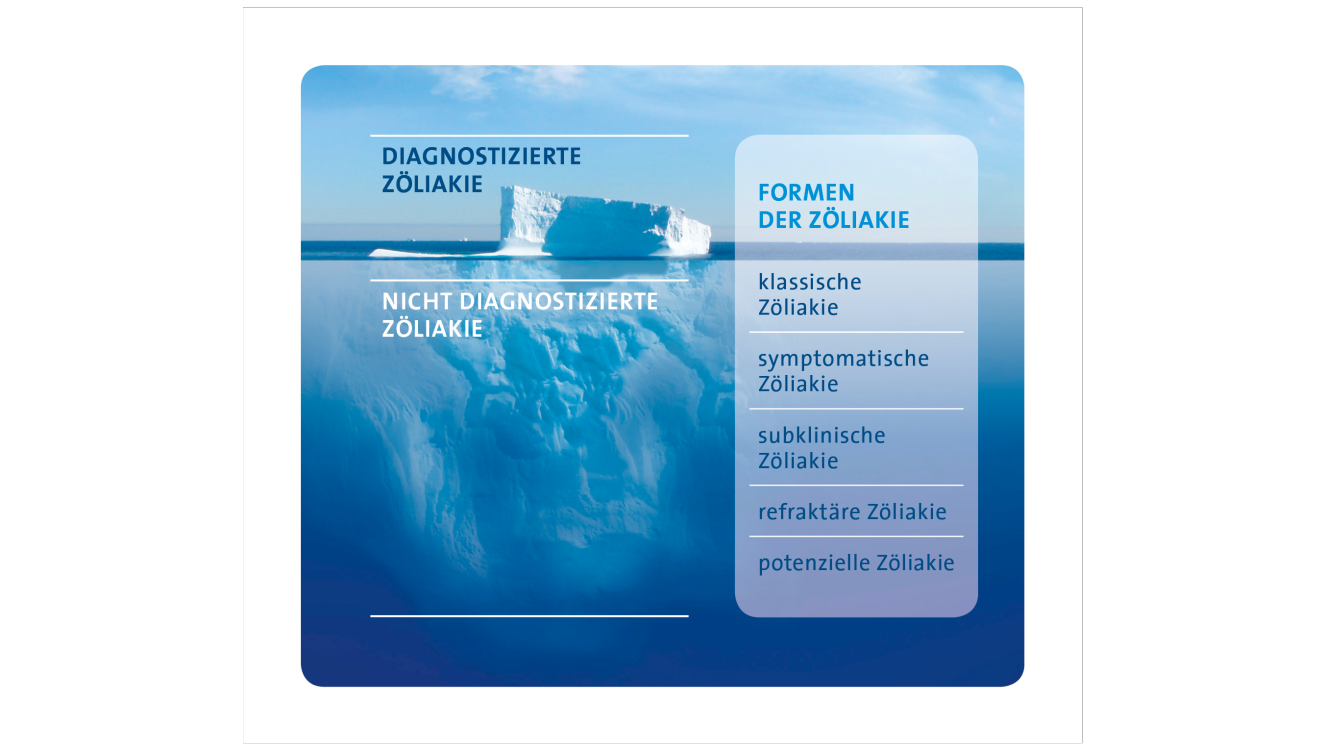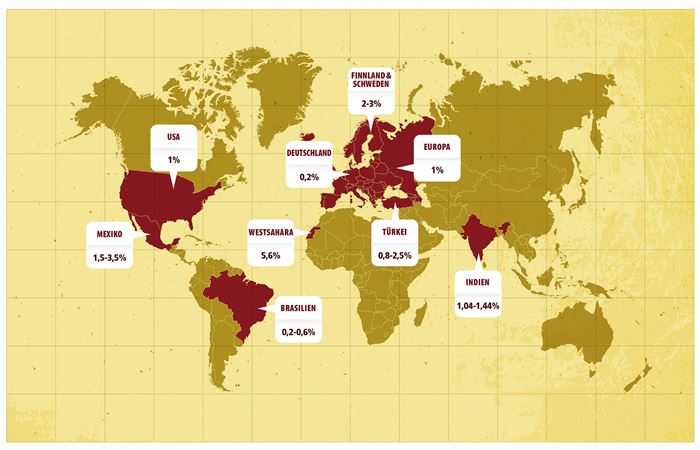Epidemiologie - Prävalenz der Zöliakie
Weltweit ist die Zöliakie eine der meistverbreiteten Unverträglichkeiten. Je nach Land ist bis zu ein Prozent der Bevölkerung betroffen, wie Zahlen aus Screeninguntersuchungen zeigen. Für Deutschland liegt die Prävalenz bei circa 1 Prozent.
Zöliakie galt lange Zeit als seltene Kinderkrankheit. Noch vor 20 Jahren lag die Prävalenz bei 1 : 1.000 bis 1 : 2.000. Diese Daten stützten sich auf das Vorkommen manifester Erkrankungen und typischer Zöliakieformen. Durch die Entdeckung der verschiedenen Zöliakieantikörper und die Weiterentwicklung der Screeninguntersuchungen der letzten Jahre hat sich gezeigt, dass Zöliakie weitaus häufiger vorkommt als angenommen. Dabei sind Frauen rund 50 Prozent häufiger betroffen als Männer. In verschiedenen Ländern wurde eine Prävalenz der Zöliakie von 1 : 100 bis 1 : 500 beschrieben. Das heißt, dass bis zu ein Prozent der Bevölkerung von Zöliakie betroffen ist. In Deutschland beträgt die Prävalenz circa 1 Prozent.
Eisberg der Zöliakie
Die meisten Zöliakiefälle sind asymptomatisch, weisen also nicht die typische Verlaufsform auf und werden deshalb lange nicht entdeckt. Die Zeitspanne zwischen dem Auftreten der ersten Symptome und der Diagnose Zöliakie kann bei bis zu sieben Jahren liegen. Man hat errechnet, dass auf einen diagnostizierten drei bis fünf nicht diagnostizierte Zöliakiebetroffene kommen. Man spricht in diesem Zusammenhang auch vom Eisberg der Zöliakie, da so viele Fälle unentdeckt bleiben.Altersgipfel der Zöliakie
Inzwischen wird die Zöliakie vermehrt im Erwachsenenalter diagnostiziert. Lag das mittlere Patientenalter bei der Erstdiagnose vor 1981 noch bei circa 30 Jahren, liegt es heute zwischen 40 und 45 Jahren. Mit zunehmendem Alter hat sich auch das klinische Bild der Zöliakie gewandelt, da bei vielen Patienten, die erst im Erwachsenenalter diagnostiziert werden, eine symptomatische Zöliakie mit extraintestinalen Symptomen vorliegt.
Eisberg der Zöliakie: Da die meisten Zöliakiefälle aufgrund der unspezifischen Symptomatik unentdeckt bleiben, spricht man auch vom Eisbergphänomen der Zöliakie.
Quellen
- Catassi C., Gatti S., Fasano A. The New Epidemiology of Celiac Disease Journal of Pediatric Gastroenterology & Nutrition, July 2014 Volume 59.
- Mustalahti et al., The prevalence of celiac disease in Europe: Results of a centralized, international mass screening project. Annals of Medicine 2010 Dec;42(8):587-95.
Weiterführende Informationen
E-Learning
1
Alle anzeigen
Fachartikel
1
Alle anzeigen
Studien
4
Alle anzeigen

Modul 1 - Grundlagen der Zöliakie Teil 1
In diesem Modul werden Ihnen erste Grundlagen zur Zöliakie vermittelt. Die Begrifflichkeiten „Zöliakie“ und „Gluten“ werden definiert.
Im Weiteren geht es um die Ätiologie und Pathogenese der Zöliakie. Es werden exogene, genetische und immunologische Faktoren, die bei der Entstehung einer Zöliakie eine Rolle spielen, präsentiert. Es folgt die Darlegung der einzelnen Erscheinungsformen der Zöliakie, die vielfältige Symptomatik sowie ein Überblick über die Prävalenz in Europa und ihrer Entwicklung.
Zusammengestellt wurde das Modul von Dr. med. Michael Schumann von der Berliner Charité.
Im Weiteren geht es um die Ätiologie und Pathogenese der Zöliakie. Es werden exogene, genetische und immunologische Faktoren, die bei der Entstehung einer Zöliakie eine Rolle spielen, präsentiert. Es folgt die Darlegung der einzelnen Erscheinungsformen der Zöliakie, die vielfältige Symptomatik sowie ein Überblick über die Prävalenz in Europa und ihrer Entwicklung.
Zusammengestellt wurde das Modul von Dr. med. Michael Schumann von der Berliner Charité.

Modul 1 - Grundlagen der Zöliakie Teil 1





In diesem Modul werden Ihnen erste Grundlagen zur Zöliakie vermittelt....

Die Weltkarte der Zöliakie
In diesem Artikel wird die abwechselnde Häufigkeit erörtert, mit der Zöliakie in „Zeit und Raum“ auftritt. Diese Information ist nicht nur für statistische Zwecke relevant, sondern dient vor allem dazu, Hypothesen über jene Faktoren zu formulieren, die zur Entwicklung dieser in der heutigen Gesellschaft derart verbreiteten Pathologie beitragen.
>> Weiterlesen... <<<
>> Weiterlesen... <<<

Die Weltkarte der Zöliakie
In diesem Artikel wird die abwechselnde Häufigkeit erörtert, mit der Z...

Is gluten the great etiopathogenic agent of disease in the XXI century?
Abstract
Introduction: Gluten is a glycoprotein present in some cereals. The incidence of disorders related to gluten, including the EC, is increasing, even pathologies far from an etiology or treatment with GFD.
Aims: Review the scientific literature related to the ingestion of gluten and pathogenesis of different diseases.
Methods: A literature search in major scientific database.
Results: We obtained from the following diseases, gluten ataxia, multiple sclerosis, autism spectrum disorder, schizophrenia, attention deficit hyperactivity disorder, depressive disorders, headaches, irritable bowel syndrome, fibromyalgia, dermatitis herpetiformis and epilepsy, studies in which either a determination of gliadin was referred or a treatment, with/without gluten, was applied and evaluated.
Conclusion: The ingestion of gluten seems to be related to disease, when there is no EC, SGNC or wheat allergy. Suspicions about the benefit of GFD as a complementary treatment is borne in semi-clinical trials and cohorts, either as a causal factor in the pathogenesis, or improvement of symptoms.
Resource: Nutr Hosp. 2014;30(6):1203-1210
Ismael San Mauro Martín, Elena Garicano Vilar, Luis Collado Yurrutia y María José Ciudad Cabañas
Introduction: Gluten is a glycoprotein present in some cereals. The incidence of disorders related to gluten, including the EC, is increasing, even pathologies far from an etiology or treatment with GFD.
Aims: Review the scientific literature related to the ingestion of gluten and pathogenesis of different diseases.
Methods: A literature search in major scientific database.
Results: We obtained from the following diseases, gluten ataxia, multiple sclerosis, autism spectrum disorder, schizophrenia, attention deficit hyperactivity disorder, depressive disorders, headaches, irritable bowel syndrome, fibromyalgia, dermatitis herpetiformis and epilepsy, studies in which either a determination of gliadin was referred or a treatment, with/without gluten, was applied and evaluated.
Conclusion: The ingestion of gluten seems to be related to disease, when there is no EC, SGNC or wheat allergy. Suspicions about the benefit of GFD as a complementary treatment is borne in semi-clinical trials and cohorts, either as a causal factor in the pathogenesis, or improvement of symptoms.
Resource: Nutr Hosp. 2014;30(6):1203-1210
Ismael San Mauro Martín, Elena Garicano Vilar, Luis Collado Yurrutia y María José Ciudad Cabañas

The New Epidemiology of Celiac Disease
Abstract
The prevalence of celiac disease (CD) varies greatly, but several reports have shown that CD is increasing in frequency in different geographic areas. The increase in prevalence can be partially attributed to the improvement in diagnostic techniques and disease awareness; however the equally well documented rise in incidence in the last 30–40 years cannot be so easily explained. The new epidemiology of CD is now characterized by an increase of new cases in the historical CD areas (northern Europe and the United States) and more interestingly in a spread of the disease in new regions (Asian countries). A significant change in diet habits, particularly in gluten consumption as well as in infant feeding patterns are probably the main factors that can account for these new trends in CD epidemiology.
Resource: Journal of Pediatric Gastroenterology & Nutrition, July 2014 Volume 59
The prevalence of celiac disease (CD) varies greatly, but several reports have shown that CD is increasing in frequency in different geographic areas. The increase in prevalence can be partially attributed to the improvement in diagnostic techniques and disease awareness; however the equally well documented rise in incidence in the last 30–40 years cannot be so easily explained. The new epidemiology of CD is now characterized by an increase of new cases in the historical CD areas (northern Europe and the United States) and more interestingly in a spread of the disease in new regions (Asian countries). A significant change in diet habits, particularly in gluten consumption as well as in infant feeding patterns are probably the main factors that can account for these new trends in CD epidemiology.
Resource: Journal of Pediatric Gastroenterology & Nutrition, July 2014 Volume 59

Incidence and Prevalence of Celiac Disease and Dermatitis Herpetiformis in the UK Over Two Decades: Population-Based Study
Abstract
OBJECTIVES:
Few studies have quantified the incidence and prevalence of celiac disease (CD) and dermatitis herpetiformis (DH) nationally and regionally by time and age groups. Understanding this epidemiology is crucial for hypothesizing about causes and quantifying the burden of disease.
METHODS:
Patients with CD or DH were identified in the Clinical Practice Research Datalink between 1990 and 2011. Incidence rates and prevalence were calculated by age, sex, year, and region of residence. Incidence rate ratios (IRR) adjusted for age, sex, and region were calculated with Poisson regression.
RESULTS:
A total of 9,087 incident cases of CD and 809 incident cases of DH were identified. Between 1990 and 2011, the incidence rate of CD increased from 5.2 per 100,000 (95% confidence interval (CI), 3.8–6.8) to 19.1 per 100,000 person-years (95% CI, 17.8–20.5; IRR, 3.6; 95% CI, 2.7–4.8). The incidence of DH decreased over the same time period from 1.8 per 100,000 to 0.8 per 100,000 person-years (average annual IRR, 0.96; 95% CI, 0.94–0.97). The absolute incidence of CD per 100,000 person-years ranged from 22.3 in Northern Ireland to 10 in London. There were large regional variations in prevalence for CD but not DH.
CONCLUSIONS:
We found a fourfold increase in the incidence of CD in the United Kingdom over 22 years, with large regional variations in prevalence. This contrasted with a 4% annual decrease in the incidence of DH, with minimal regional variations in prevalence. These contrasts could reflect differences in diagnosis between CD (serological diagnosis and case finding) and DH (symptomatic presentation) or the possibility that diagnosing and treating CD prevents the development of DH.
Resource: Am J Gastroenterol. May 2014
OBJECTIVES:
Few studies have quantified the incidence and prevalence of celiac disease (CD) and dermatitis herpetiformis (DH) nationally and regionally by time and age groups. Understanding this epidemiology is crucial for hypothesizing about causes and quantifying the burden of disease.
METHODS:
Patients with CD or DH were identified in the Clinical Practice Research Datalink between 1990 and 2011. Incidence rates and prevalence were calculated by age, sex, year, and region of residence. Incidence rate ratios (IRR) adjusted for age, sex, and region were calculated with Poisson regression.
RESULTS:
A total of 9,087 incident cases of CD and 809 incident cases of DH were identified. Between 1990 and 2011, the incidence rate of CD increased from 5.2 per 100,000 (95% confidence interval (CI), 3.8–6.8) to 19.1 per 100,000 person-years (95% CI, 17.8–20.5; IRR, 3.6; 95% CI, 2.7–4.8). The incidence of DH decreased over the same time period from 1.8 per 100,000 to 0.8 per 100,000 person-years (average annual IRR, 0.96; 95% CI, 0.94–0.97). The absolute incidence of CD per 100,000 person-years ranged from 22.3 in Northern Ireland to 10 in London. There were large regional variations in prevalence for CD but not DH.
CONCLUSIONS:
We found a fourfold increase in the incidence of CD in the United Kingdom over 22 years, with large regional variations in prevalence. This contrasted with a 4% annual decrease in the incidence of DH, with minimal regional variations in prevalence. These contrasts could reflect differences in diagnosis between CD (serological diagnosis and case finding) and DH (symptomatic presentation) or the possibility that diagnosing and treating CD prevents the development of DH.
Resource: Am J Gastroenterol. May 2014

Coeliac disease
Summary points
Adult coeliac disease is a common autoimmune condition with an estimated prevalence of 1%. Test for coeliac disease in patients with unexplained anaemia, weight loss, diarrhoea, or gastrointestinal symptoms, particularly irritable bowel syndrome, and in first degree relatives of index cases. Confirm the diagnosis with duodenal biopsy in all adult patients. Treatment with a lifelong strict gluten-free diet is currently the only treatment of known effectiveness. Patients should have access to an expert dietitian for advice on a gluten-free diet and for assessment of adherence if symptoms persist on institution of the diet. Regular follow-up is necessary to assess adherence and micronutrient deficiency.
Coeliac disease is a common autoimmune condition characterised by a heightened immunological response to ingested gluten, with estimated prevalence rates in adults of 0.2-1% in the United States and Europe. Contemporary studies suggest that the prevalence of this disease is increasing.3 4 5 Meta-analyses have shown that for every patient identified as having coeliac disease seven to eight remain undiagnosed. Here, we will summarise recent evidence on how the investigation and diagnosis of coeliac disease can be improved and also provide an evidence based approach to managing patients with newly diagnosed coeliac disease and those who do not respond to a gluten-free diet as expected. Evidence is taken from meta-analyses, systematic reviews, and randomised controlled trials where possible.
Sources and selection criteria
We searched Medline and the Cochrane Database of Systematic Reviews with the search terms “coeliac disease” or “celiac disease”. Studies included those in adult and paediatric populations but preference was given to adult studies in the past five years. We focused on meta-analyses and systematic reviews where possible.
Who gets coeliac disease?
In the past coeliac disease was considered to be a disease that affects white populations only, but it is now clear that coeliac disease is a global problem. Clinicians in …
Resource: BMJ 2014; (Published 3 March 2014)
Peter D Mooney, clinical research fellow gastroenterology, Marios Hadjivassiliou, professor of neurology and NHS consultant, David S Sanders, professor of gastroenterology and NHS consultant
Adult coeliac disease is a common autoimmune condition with an estimated prevalence of 1%. Test for coeliac disease in patients with unexplained anaemia, weight loss, diarrhoea, or gastrointestinal symptoms, particularly irritable bowel syndrome, and in first degree relatives of index cases. Confirm the diagnosis with duodenal biopsy in all adult patients. Treatment with a lifelong strict gluten-free diet is currently the only treatment of known effectiveness. Patients should have access to an expert dietitian for advice on a gluten-free diet and for assessment of adherence if symptoms persist on institution of the diet. Regular follow-up is necessary to assess adherence and micronutrient deficiency.
Coeliac disease is a common autoimmune condition characterised by a heightened immunological response to ingested gluten, with estimated prevalence rates in adults of 0.2-1% in the United States and Europe. Contemporary studies suggest that the prevalence of this disease is increasing.3 4 5 Meta-analyses have shown that for every patient identified as having coeliac disease seven to eight remain undiagnosed. Here, we will summarise recent evidence on how the investigation and diagnosis of coeliac disease can be improved and also provide an evidence based approach to managing patients with newly diagnosed coeliac disease and those who do not respond to a gluten-free diet as expected. Evidence is taken from meta-analyses, systematic reviews, and randomised controlled trials where possible.
Sources and selection criteria
We searched Medline and the Cochrane Database of Systematic Reviews with the search terms “coeliac disease” or “celiac disease”. Studies included those in adult and paediatric populations but preference was given to adult studies in the past five years. We focused on meta-analyses and systematic reviews where possible.
Who gets coeliac disease?
In the past coeliac disease was considered to be a disease that affects white populations only, but it is now clear that coeliac disease is a global problem. Clinicians in …
Resource: BMJ 2014; (Published 3 March 2014)
Peter D Mooney, clinical research fellow gastroenterology, Marios Hadjivassiliou, professor of neurology and NHS consultant, David S Sanders, professor of gastroenterology and NHS consultant

Is gluten the great etiopathogenic agent of disease in the XXI century?
Abstract
Introduction: Gluten is a glycoprotein present in some cer...

The New Epidemiology of Celiac Disease
Abstract
The prevalence of celiac disease (CD) varies greatly, but ...

Incidence and Prevalence of Celiac Disease and Dermatitis Herpetiformis in the UK Over Two Decades: Population-Based Study
Abstract
OBJECTIVES:
Few studies have quantified the incidence and...

Coeliac disease
Summary points
Adult coeliac disease is a common autoimmune conditi...
www.drschaer-institute.com

